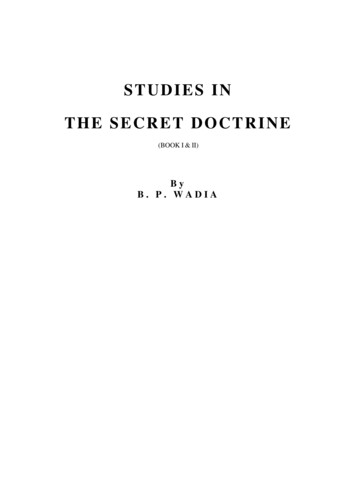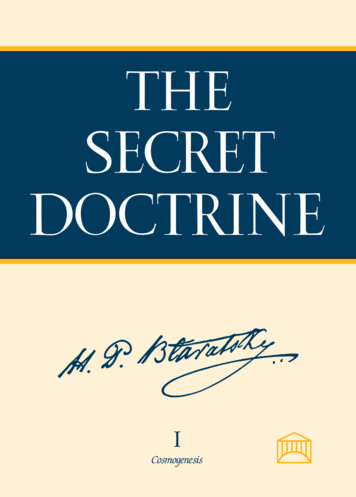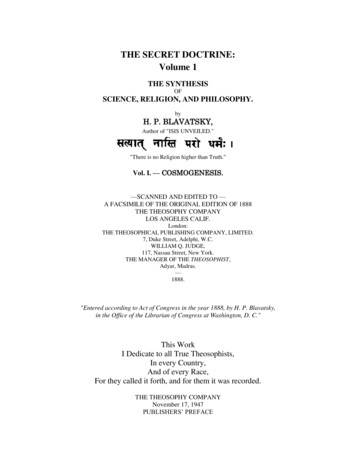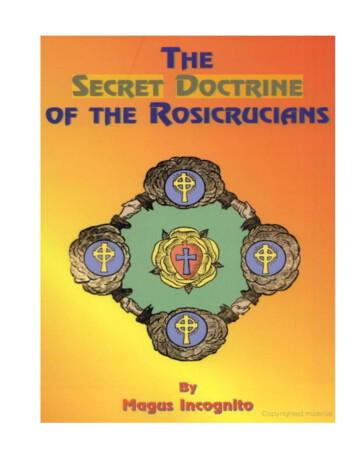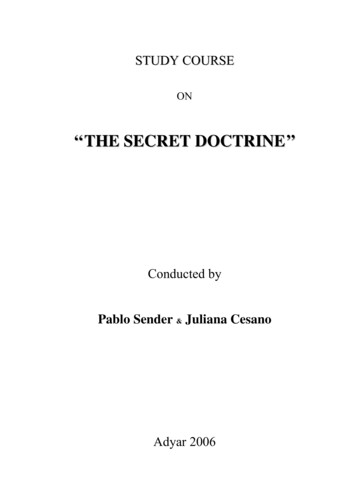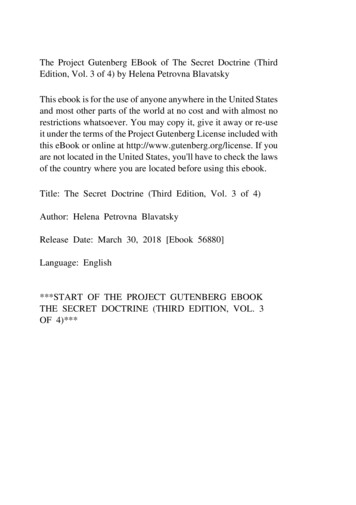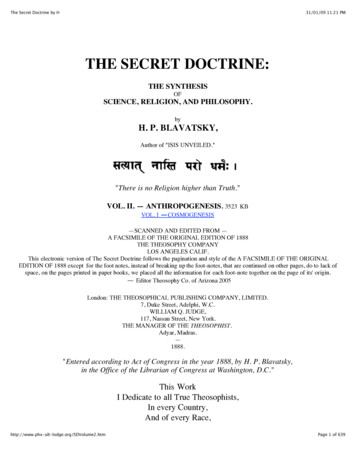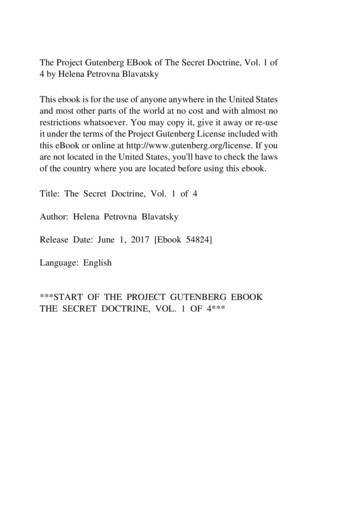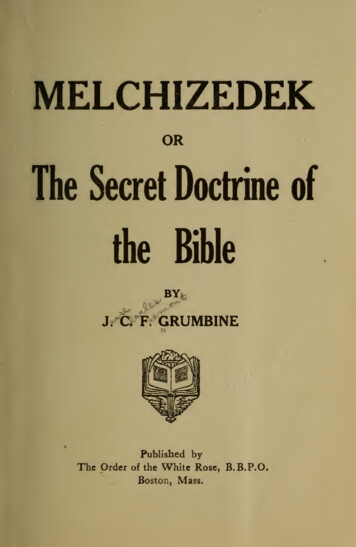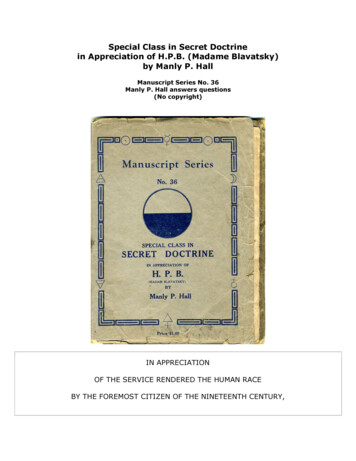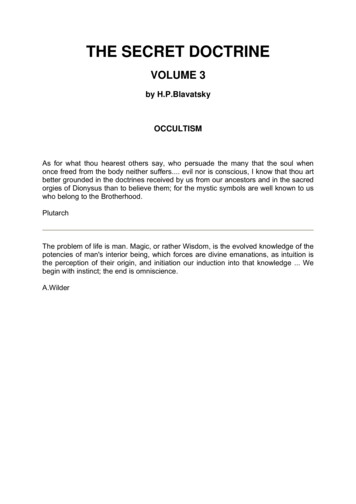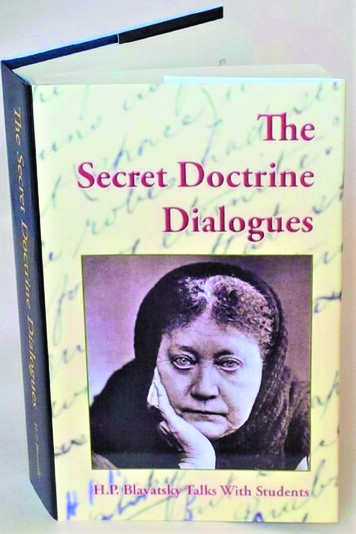
Transcription
H.P. BlavatskyTHE SECRET DOCTRINE DIALOGUESH.P. Blavatsky Talks With Students
H.P. BlavatskyTHE SECRET DOCTRINEDIALOGUESH.P. Blavatsky Talks With StudentsTHE THEOSOPHY COMPANYLOS ANGELES, CALIFORNIA2014
First Edition 2014The Theosophy CompanyLos Angeles, CaliforniaISBN 978-0-9898541-0-8
ContentsIntroductioniThe Stanzas of DzyanvOriginal Manuscript Page 1 A photocopy.xiv1. Meeting January 10, 1889Stanza 1, Slokas 1-2:Parabrahm, Ain-Soph; Laya centers; protyle and hyle; time,space and duration; Sat, “Be-ness”; the nature of intelligenceand consciousness; the logoi.12. Meeting January 17, 1889Stanza 1, Slokas 3-4:Universal mind; consciousness; the Ah-hi; cosmic ideation;deep sleep; Buddhi and Mahat; four truths of Buddhism; theNidanas and Maya; dreams; instinct; the cerebrum and thecerebellum.273. Meeting January 24, 1889Stanza 1, Slokas 5-8:Buddhism; space; Darkness and Light; Father-Mother-Son;Laya; Parabrahm, the causeless cause, Sat, rootless root;dreamless sleep; the senses; clairvoyance; light, sound andcolor.594. Meeting January 31, 1889Stanza 1, Slokas 6 & 9; Stanza 2, Slokas 1-2:Dhyan-Chohans, Planetary spirits; planets; the Builders;Dhyani-Buddhas, Manus and Rishis; the Sephiroth; Alayaand Jivatma; Planetary chains; Rishis and Manus; water, fireand occultism; modern science and hypotheses; inductionand deduction.951295. Meeting February 7, 1889Stanza 2, Slokas 3-4:Three logoi; the point in the circle; the Mundane, Solar and
Universal Eggs; potentiality and potency; Fohat, “Pho”;Astral Light; Pythagorean geometry, numbers; Triangles andPyramids; the Tetragrammaton and Tetraktys; “Yod-he-va,”the Elohim.6. Meeting February 14, 1889153Stanza 3, Slokas 1-3:The first Logos; Duration and Time; radiation and emanation;Akasa and Astral Light; early Christianity; noumena andphenomena; Dhyan-Chohans and Dhyani-Buddhas; Manu;Manvantaras; cosmic elements and elementals; the fate ofmediums; Water; the Virgin-Egg; language; thought and ideas.7. Meeting February 21, 1889191Stanza 3, Slokas 2-4:Vibration and germ; Pythagorean triangle; “Radiant Essence”;Paramatma and Jivatma; atoms and molecules; ether andAkasa; elements; “world-stuff”; war in heaven; 14 Manus;seven rays; numbers and principles; colors and prisms; RalstonSkinner and the Kabalah; the pyramids.8. Meeting February 28, 1889223Stanza 3, Slokas 5-9:The Root; the Milky Way and “world-stuff”; Light and Time;“knots” of Fohat; the Sun; nebular theory; sun spots; Fire;weight and gravity; Water; numbers and colors; Kwan-shaiyin and Kwan-yin; Oeaohoo; the veil of reality; Electricityand Fohat; the kama-rupa of amber and electricity; the ant;organic and inorganic matter; Fire; Keely’s inter-etheric force;Thompson and Crookes; suns and planets; the atmosphere.9. Meeting March 7, 1889257Stanza 3, Slokas 10-11:Æther and Akasa; ether and Astral Light; the circle; the Webof the Universe; the Monad; planets and gravity; one absoluteforce; the Absolute.
10. Meeting March 14, 1889295Stanza 4, Slokas 1-5:“Sons of the Fire”; Nirvana; Father-Mother; Kabalisticpermutation; the Alhim (Elohim); the Logos; “godgeometrizes”; suns, comets, meteors and planets; the Pleiades.11. Meeting March 21, 1889323Stanza 4, Sloka 6; Stanza 5, Slokas 1-3:The Lipika, Æons, the Syzygies of Simon Magus; Word, Voiceand Spirit; “the rejected Son”; Mahat; the Absolute; the atoms;“Sons of Fohat”.12. Meeting March 28, 1889341Stanza 4, Sloka 5; Stanza 5, Slokas 1-5:The Sun and planets; comets, cosmic dust and nebula; Fohat;atoms; electricity; the Caduceus of Mercury; the Hindutrinity; the four corners; magnetic influences.13. Meeting April 4, 1889371Stanza 5, Sloka 6; Stanza 6, Slokas 1 & 3-4:Personal Ego and Impersonal Self; Atma-Buddhi-Manas; Vach;Laya centers; Fohat and the Mayavi-rupa; pralayas; Atoms;Force; Light and Heat; Nirvana and Parinirvana; Globes,Rounds and Races; the Moon Chain; Keely’s telescope.14. Meeting April 11, 1889403Stanza 6, Sloka 4:Atmospheres and elements; meteors; minerals; atoms andmolecules; Laya centers and primordial substance; Fohat,electricity and Energy; influence of the Moon; magnetism;Mars, Mercury.42915. Meeting April 18, 1889Laya centers, matter and substance; seven planes of substance;triangle and square; classes of Monads; perfection in evolution;Mt. Meru; the Sishtas; anthropoids; populations; the Todasand Mulakurumbas of India.
16. Meeting April 25, 1889457Stanza 6, Sloka 5:The moon and earth; motion; Fohat; Lunar Pitris; Rounds,globes and principles; karma of civilization; Nature; KamaRupa and Prana.49117. Meeting May 2, 1889Stanza 6, Slokas 5-6:“The Dragon”; Saturn; cosmic “seats”; Kabalah; Cosmic Consciousness; seeds and atoms; Chaos and Eros; the struggle forexistence; selfishness; elliptic and parabolic orbits; states ofmatter.18. Meeting May 9, 1889: Transcription missing.19. Meeting May 16, 1889523“The Key to Theosophy”; practical theosophy; Father Damienand Labro; altruism; growth of the Theosophical Society;pseudo-Theosophists; influences of planets and color;Theosophists and Mystics; basic theosophy.20. Meeting May 30, 1889549Stanza 7, Slokas 1-3:Prana, Jiva and Monads; the Unknown and the Unknowable;Manas; the brain; Karma and heredity; the Fourth Round.21. Meeting June 6, 1889575“The Key to Theosophy”; Karma, unmerited suffering;Devachan; free will; memory; reincarnation.22. Meeting June 20, 1889607Materialism and understanding; natural forces and hierarchies;Theosophy and fanaticism; intuition; Atma, Buddhi andManas; Jiva and Prana.No evidence exists that meetings were held May 23 or June13, 1889.
Appendix 1Possible missing fragment from Meeting 1, page 4.635Appendix 2636“Appendix on Dreams” from The Transactions of the BlavatskyLodge.Appendix 3Blavatsky Lodge Meetings:Participants and the meetings they attended.655659Appendix 4The Secret Doctrine: A Paper read before the Blavatsky Lodgeof the T.S. by William Kingsland, President.Index665lLlLlL
iIntroductionThe modern Theosophical movement, inaugurated in 1875 byH. P. Blavatsky and others with the formation of the TheosophicalSociety, had nearly perished by the time HPB moved to Londonin May of 1887. Although a worldly success, attacks from withoutand a lack of support from within had rendered the Society almostlifeless. Psychic phenomena, and a general misunderstanding of thenature of the “masters” and the principle of Universal Brotherhood –the fundamental purpose of the Movement – had distracted both theSociety and the world’s attention from the deeper teachings.Retreating to Europe to regain her health and to re-group amongfriends, HPB had left India in 1885, ill, exhausted, near death infact, yet determined to carry on with the work her teachers had setfor her. At last, she was able to gather about her a revitalized nucleusof workers, which came to be called the Blavatsky Lodge. The nextfour years produced a flourish of wonderfully productive activity,beginning with a new magazine, Lucifer, in the fall of 1887. Theadditional helping hands allowed HPB to focus upon and completeThe Secret Doctrine by 1888, and The Key to Theosophy and The Voiceof the Silence the following year.Once published, The Secret Doctrine proved to be a tremendouscatalyst for serious student inquiry. Questions about the book andits subjects, particularly cosmogenesis, were the topic of the weeklymeetings of the Blavatsky Lodge, held at HPB’s home on LansdowneRoad. Students of Theosophical history will no doubt recognize manyof the names of prominent Theosophists of the day who attended. Ina letter to her sister, Vera, HPB gives a behind-the-scenes glimpse ofthose proceedings:Every Saturday we hold a reception and every Thursday a meeting,with all its scientific questions, with shorthand writers at my back,and with a couple of reporters in corners. Does not all this taketime? I have to prepare myself for every Thursday, because thepeople who attend these meetings are not ignoramuses, but men
iiintroductionsuch as Kingsland, the worker in electricity, as Dr. William Bennett,and the naturalist, Carter Blake. I have to be ready to defend thetheories of occultism against those of applied sciences so that it willbe possible to print them straight away from the shorthand reportsin our new special monthly magazine under the title of Transactionsof the Blavatsky Lodge.The first installment of the Transactions was published a year later,in 1890, carrying a note that the printed version was “somewhatcondensed from the original discussions,” and presenting the materialin an anonymous question and answer format. Another volumeshortly followed, and though others were indicated, nothing furtherappeared. The recorded weekly meetings were held from January10 to June 20, 1889, but the published accounts only covered themeetings up to March 14. Two meetings also took place in December,1888, and resulted in the Appendix on Dreams included in the firstvolume, and included here as Appendix 2, making the present worka complete record of the dialogues H. P. Blavatsky held with herstudents over a seven month period.This material, 21 handwritten folios of over 30 pages each,provides a useful commentary on the ideas expounded in The SecretDoctrine. As much as possible, it is a word-for-word transcriptionfrom the original handwritten reports of the meetings (A sample,page one of the original MS, follows.) The report of the first meetingof January 10, 1889 is unique in that it bears HPB’s handwritteneditorial changes, which differ from the version published at thetime. Among the many changes made to the first dozen or so pageswas her crossing out “Madame Blavatsky” and inserting “HPB.”Her preference for the latter designation is well-known, and mostparticipants in the dialogues reported herein so referred to her, butwe have maintained the former designation when it was used by thestenographers. At the meeting of May 16 and after, the discussionsturned to a new project HPB was working on,The Key to Theosophy,and karma, reincarnation, and the after-death states were among thetopics covered. Students will find in these dialogues a faithful accountof HPB speaking clearly and providing much food for thought.
introductioniiiThe sentence structure of the reports has been maintained asrecorded, wherever possible. Only minor editing has been donefor uniformity of punctuation and spelling of words, which areleft in the original British English used by the stenographers. Anyadditions, which are few and provided for the sake of readability, areindicated by the following parentheses { }. Sometimes the text of thehandwritten reports contains a blank space where the stenographerwas unable to get a word or term, and this is indicated by brackets[ ]. Occasionally, parts of the MS text were crossed out, perhapsby HPB herself, and have been included in brackets [thus]. Allfootnotes are by the transcribers. Sanskrit terms are given as closelyas possible to those used by HPB, who followed the forms generallyin use in her time.This volume is intended neither to replace nor to correct theexisting Transactions of the Blavatsky Lodge, but may be viewed as acompanion work. A comparison with the Transactions immediatelyshows how much HPB edited the latter, yet these transcriptionsprovide a powerful, first-hand introduction to HPB in discussion.We are treated to her broad, philosophical and penetrating mind,her biting wit, her gentle and not-so-gentle impatience with humanfoibles, and her self-deprecating willingness to inquire into ideas andengage the minds of others.These are real dialogues, based on the most difficult, abstrusematerial of the early pages of The Secret Doctrine: the nature of reality,the substance of the universe, the basis and nature of consciousness,mind and matter. The questions come from some of the best, openyoung minds of the time, and anticipate many still pondered today.Here is HPB direct – wise, articulate, grumpy, sharp, raw, unedited– and we are given a “fly-on-the-wall” ear to the world’s first studyclass in The Secret Doctrine, with the author, or writer, rather, HPBherself presiding!lLlLlL
vCOSMIC EVOLUTION.In Seven Stanzas translated from the Book of Dzyan.———————STANZA I.1. The eternal parent wrapped in her ever invisible robeshad slumbered once again for seven eternities.2. Time was not, for it lay asleep in the infinite bosom ofduration.3. Universal mind was not, for there were no Ah-hi tocontain it.4. The seven ways to bliss were not. The great causes ofmisery were not, for there was no one to produce and getensnared by them.5. Darkness alone filled the boundless all, for father,mother and son were once more one, and the son had notawakened yet for the new wheel, and his pilgrimage thereon.6. The seven sublime lords and the seven truths had ceasedto be, and the Universe, the son of Necessity, was immersedin Paranishpanna, to be outbreathed by that which is and yetis not. Naught was.7. The causes of existence had been done away with; thevisible that was, and the invisible that is, rested in eternalnon-being—the one being.8. Alone the one form of existence stretched boundless,infinite, causeless, in dreamless sleep; and life pulsatedunconscious in universal space, throughout that allpresence which is sensed by the opened eye of the Dangma.9. But where was the Dangma when the Alaya of the universewas in Paramartha and the great wheel was Anupadaka?———
viSTANZA II.1. . . . Where were the builders, the luminous sons ofManvantaric dawn? . . . In the unknown darkness in their Ahhi Paranishpanna. The producers of form from no-form—theroot of the world—the Devamatri and Svâbhâvat, rested inthe bliss of non-being.2. . . . Where was silence? Where the ears to sense it? No,there was neither silence nor sound; naught save ceaselesseternal breath, which knows itself not.3. The hour had not yet struck; the ray had not yet flashedinto the Germ; the Matripadma had not yet swollen.4. Her heart had not yet opened for the one ray to enter,thence to fall, as three into four, into the lap of Maya.5. The seven sons were not yet born from the web of light.Darkness alone was father-mother, Svâbhâvat; and Svâbhâvatwas in darkness.6. These two are the Germ, and the Germ is one. TheUniverse was still concealed in the Divine thought and theDivine bosom. . . .———STANZA III.1. . . . The last vibration of the seventh eternity thrillsthrough infinitude. The mother swells, expanding fromwithin without, like the bud of the lotus.2. The vibration sweeps along, touching with its swift wingthe whole universe and the germ that dwelleth in darkness:the darkness that breathes over the slumbering waters oflife. . .3. Darkness radiates light, and light drops one solitary rayinto the mother-deep. The ray shoots through the virgin
viiegg, the ray causes the eternal egg to thrill, and drop thenon-eternal germ, which condenses into the world-egg.4. Then the three fall into the four. The radiant essencebecomes seven inside, seven outside. The luminous egg, whichin itself is three, curdles and spreads in milk-white curdsthroughout the depths of mother, the root that grows inthe depths of the ocean of life.5. The root remains, the light remains, the curds remain,and still Oeaohoo is one.6. The root of life was in every drop of the ocean ofimmortality, and the ocean was radiant light, which wasfire, and heat, and motion. Darkness vanished and was nomore; it disappeared in its own essence, the body of fire andwater, or father and mother.7. Behold, oh Lanoo! The radiant child of the two, theunparalleled refulgent glory: Bright Space Son of DarkSpace, which emerges from the depths of the great darkwaters. It is Oeaohoo the younger, the * * * He shines forthas the son; he is the blazing Divine Dragon of Wisdom; theOne is Four, and Four takes to itself Three,1 and the Unionproduces the Sapta, in whom are the seven which becomethe Tridasa (or the hosts and the multitudes). Behold himlifting the veil and unfurling it from east to west. He shutsout the above, and leaves the below to be seen as the greatillusion. He marks the places for the shining ones, and turnsthe upper into a shoreless sea of fire, and the one manifestedinto the great waters.8. Where was the germ and where was now darkness? Whereis the spirit of the flame that burns in thy lamp, oh Lanoo?The germ is that, and that is light, the white brilliant sonof the dark hidden father.1 In the English translation from the Sanskrit the numbers are given in thatlanguage, Eka, Chatur, etc., etc. It was thought best to give them in English.
viii9. Light is cold flame, and flame is fire, and fire producesheat, which yields water: the water of life in the greatmother.10. Father-Mother spin a web whose upper end is fastenedto spirit—the light of the one darkness—and the lower oneto its shadowy end, matter; and this web is the universe spunout of the two substances made in one, which is Svâbhâvat.11. It expands when the breath of fire is upon it; it contractswhen the breath of the mother touches it. Then the sonsdissociate and scatter, to return into their mother’s bosomat the end of the great day, and re-become one with her;when it is cooling it becomes radiant, and the sons expandand contract through their own selves and hearts; theyembrace infinitude.12. Then Svâbhâvat sends Fohat to harden the atoms. Eachis a part of the web. Reflecting the “Self-Existent Lord” likea mirror, each becomes in turn a world.————STANZA IV.1. . . . Listen, ye Sons of the Earth, to your instructors—the Sons of the Fire. Learn, there is neither first nor last,for all is one: number issued from no number.2. Learn what we who descend from the Primordial Seven,we who are born from the Primordial Flame, have learntfrom our fathers. . . .3. From the effulgency of light—the ray of the everdarkness—sprung in space the re-awakened energies; the onefrom the egg, the six, and the five. Then the three, the one,the four, the one, the five—the twice seven the sum total.And these are the essences, the flames, the elements, thebuilders, the numbers, the arupa, the rupa, and the force
ixof Divine Man—the sum total. and from the Divine Manemanated the forms, the sparks, the sacred animals, and themessengers of the sacred fathers within the holy four.4. This was the army of the voice—the divine mother ofthe seven. The sparks of the seven are subject to, and theservants of, the first, the second, the third, the fourth, thefifth, the sixth, and the seventh of the seven. These “sparks”are called spheres, triangles, cubes, lines, and modellers;for thus stands the Eternal Nidana—the Oeaohoo, whichis:5. “Darkness” the boundless, or the no-number, Adi-NidanaSvâbhâvat:—I. The Adi-Sanat, the number, for he is one.II. The voice of the Lord Svâbhâvat, the numbers, for heis one and nine.III. The “formless square.” And these three enclosed within theare the sacredfour; and the ten are the arupa universe. Then come the“sons,” the seven fighters, the one, the eighth left out, andhis breath which is the light-maker.6. Then the second seven, who are the Lipika, producedby the three. The rejected son is one. The “Son-suns” arecountless.————STANZA V.1. The Primordial Seven, the First Seven Breaths of theDragon of Wisdom, produce in their turn from their HolyCircumgyrating Breaths the Fiery Whirlwind.2. They make of him the messenger of their will. The Dzyubecomes Fohat, the swift son of the Divine sons whose sons
xare the Lipika, runs circular errands. Fohat is the steed andthe thought is the rider. He passes like lightning throughthe fiery clouds; takes three, and five, and seven stridesthrough the seven regions above, and the seven below. Helifts his voice, and calls the innumerable sparks, and joinsthem.3. He is their guiding spirit and leader. When he commenceswork, he separates the sparks of the Lower Kingdom thatfloat and thrill with joy in their radiant dwellings, andforms therewith the germs of wheels. He places them in thesix directions of space, and one in the middle—the centralwheel.4. Fohat traces spiral lines to unite the sixth to theseventh—the crown; an army of the Sons of Light stands ateach angle, and the Lipika in the middle wheel. They say: Thisis good, the first Divine world is ready, the first is now thesecond. Then the “Divine Arupa” reflects itself in ChhayaLoka, the first garment of the Anupadaka.5. Fohat takes five strides and builds a winged wheel ateach corner of the square, for the four holy ones and theirarmies.6. The Lipika circumscribe the triangle, the first one, thecube, the second one, and the pentacle within the egg. Itis the ring called “Pass Not” for those who descend andascend. Also for those who during the Kalpa are progressingtowards the great day “Be with us.” Thus were formed theRupa and the Arupa: from one light seven lights; from eachof the seven, seven times seven lights. The wheels watch thering. . . . .————STANZA VI.1. By the power of the Mother of Mercy and Knowledge—
xiKwan-Yin—the “triple” of Kwan-shai-Yin, residing in Kwanyin-Tien, Fohat, the Breath of their Progeny, the Son of theSons, having called forth, from the lower abyss, the illusiveform of Sien-Tchang and the Seven Elements:22. The Swift and Radiant One produces the Seven LayaCentres, against which none will prevail to the great day“Be-with-Us,” and seats the Universe on these EternalFoundations surrounding Tsien-Tchan with the ElementaryGerms.3. Of the Seven—first one manifested, six concealed,two manifested, five concealed; three manifested, fourconcealed; four produced, three hidden; four and one tsanrevealed, two and one half concealed; six to be manifested,one laid aside. Lastly, seven small wheels revolving; onegiving birth to the other.4. He builds them in the likeness of older wheels, placingthem on the Imperishable Centres.How does Fohat build them? he collects the fiery dust.He makes balls of fire, runs through them, and round them,infusing life thereinto, then sets them into motion; someone way, some the other way. They are cold, he makes themhot. They are dry, he makes them moist. They shine, he fansand cools them. Thus acts Fohat from one twilight to theother, during Seven Eternities.5. At the fourth, the sons are told to create their images.One third refuses—two obey.The curse is pronounced; they will be born on the fourth,suffer and cause suffering; this is the first war.6. The older wheels rotated downwards and upwards. . . .The mother’s spawn filled the whole. There were battles2 Verse 1 of Stanza VI. is of a far later date than the other Stanzas, though stillvery ancient. The old text of this verse, having names entirely unknown to theOrientalists would give no clue to the student.
xiifought between the Creators and the Destroyers, andbattles fought for space; the seed appearing and re-appearingcontinuously.7. Make thy calculations, Lanoo, if thou wouldest learnthe correct age of thy small wheel. Its fourth spokeis our mother. Reach the fourth “fruit” of the fourthpath of knowledge that leads to Nirvana, and thou shaltcomprehend, for thou shalt see . . . . .————STANZA VII.1. Behold the beginning of sentient formless life.First the Divine, the one from the Mother-Spirit; thenthe Spiritual; the three from the one, the four from theone, and the five from which the three, the five, and theseven. These are the three-fold, the four-fold downward;the “mind-born” sons of the first Lord; the shining seven.It is they who are thou, me, him, oh Lanoo. They, who watchover thee, and thy mother earth.2. The one ray multiplies the smaller rays. Life precedesform, and life survives the last atom of form. Through thecountless rays proceeds the life-ray, the one, like a threadthrough many jewels.3. When the one becomes two, the threefold appears, andthe three are one; and it is our thread, oh Lanoo, the heartof the man-plant called Saptaparna.4. It is the root that never dies; the three-tongued flameof the four wicks. The wicks are the sparks, that draw fromthe three-tongued flame shot out by the seven—theirflame—the beams and sparks of one moon reflected in therunning waves of all the rivers of earth.5. The spark hangs from the flame by the finest thread of
xiiiFohat. It journeys through the Seven Worlds of Maya. Itstops in the first, and is a metal and a stone; it passes intothe second and behold—a plant; the plant whirls throughseven changes and becomes a sacred animal. From thecombined attributes of these, Manu, the thinker is formed.Who forms him? The seven lives, and the one life. Whocompletes him? The five-fold Lha. And who perfects the lastbody? Fish, sin, and soma. . . . .6. From the first-born the thread between the SilentWatcher and his Shadow becomes more strong and radiantwith every change. The morning sun-light has changed intonoon-day glory. . . . .7. This is thy present wheel, said the Flame to the Spark.Thou art myself, my image, and my shadow. I have clothedmyself in thee, and thou art my Vahan to the day, “Be withus,” when thou shalt re-become myself and others, thyselfand me. Then the builders, having donned their firstclothing, descend on radiant earth and reign over men—who are themselves. . . .lLlLlL
xiv
11.The Theosophical Society.Meeting on Wednesday {Thursday}, January 10, 1889at 17 Lansdowne Road, W.{Thomas B.} Harbottle Esq. — President.Mr. {B.?} Keightley (Secretary): In the Proem to The Secret Doctrine,speaking of space, this is said (reads quotation, Volume I, pp. 8 etseq.1). That is just the few words on the subject of space in the abstract: but the first Sloka of the first Stanza runs as follows: “TheEternal Parent (Space), wrapped in her ever invisible robes, hadslumbered once again for seven eternities,” and on this the first question that strikes one to ask is why is the Eternal Parent, or Space,called feminine here?Mme. Blavatsky: Perhaps it is a mistake to do so. But since it isimpossible to define Parabrahm, or that which is beyond humanconception, therefore once that we speak of that first something whichcan be conceived, we had better say “She.” In all the cosmogonies it isthe goddess and goddesses that come first, the former one becomingthe all immaculate mother from which proceed all the gods. Wehave to adopt either one or the other gender, as we cannot say IT.From IT nothing can proceed, strictly speaking, neither a radiationnor an emanation.Mr. Keightley: Is that the Egyptian Neith?Mme. Blavatsky: In truth, it is beyond Neith. But it is Neith in onesense.1 “Space is called in the esoteric symbolism ‘the Seven-Skinned Eternal MotherFather.’ It is composed from its undifferentiated to its differentiated surface ofseven layers. ‘What is that which was, is, and will be, whether there is a Universeor not; whether there be gods or none?’ asks the esoteric Senzar Catechism. Andthe answer made is — SPACE.”
2the secret doctrine dialoguesMr. Keightley: Then the IT itself is not the seven-skinned EternalFather-Mother in this Stanza?Mme. Blavatsky: Assuredly not. The IT is the beyond, the meta, theParabrahm. This which is, is the female aspect of Brahmâ, the male.Mr. Keightley: And that is what is spoken of in the Proem that Iread as the “seven-skinned Father-Mother”?Mme. Blavatsky: Yes, it becomes that at the first flutter ofdifferentiation. Then the subjective proceeds to emanate—or fallsinto the objective and becomes what they called the Mother Goddess,from which proceeds the Logos or Father God, the unmanifested.For the manifested Logos is quite a different thing again and is calledthe “Son” in all the cosmogonies.Mr. Keightley: Is the first differentiation from the absolute ITfemale always?Mme. Blavatsky: It is sexless; but the female aspect is the first itassumes. Take the Jewish Kabalah. You have “Ain-Soph” which is alsothe IT, the infinite, the endless, the boundless, the adjectives usedin conjunction with IT being negatives of every kind of attributes.From IT the negative, the zero, 0, proceeds number One, the positivewhich is Sephira or the Crown. The Talmudists say it is the “Torah,”the law, which they call the wife of “Ain-Soph.” Now see the Hinducosmogony. There you find that Parabrahm is not mentioned; butonly Mulaprakriti: there is Parabrahm and there is Mulaprakriti,which latter is the lining so to say, or the aspect of Parabrahm inthe invisible universe. Mulaprakriti means the root of matter, butParabrahm cannot be called the “root,” for it is the rootless root ofall that is. Therefore, you must begin with Mulaprakriti, the veilof Brahma as they call it. Take any cosmogony in the world: youwill always find it begins thus; the first manifestation is the MotherGoddess, the reflection, the root or the first plane of substance. From,or rather in that Mother Goddess is formed the unmanifested Logosher son and husband at once, as he is called the Concealed Father;and from these two the manifested Logos which is the Son itself—
1. meeting january 10, 18893the Architect of all the visible universe.Mr. Keightley: The second question is, “What aspect of space, orthe unknown deity ‘That,’ of which you speak further on, is herecalled the Eternal Parent”?Mme. Blavatsky: Well it is just this androgynous something; theSvabhavat of the Buddhists. It is non-differentiated, hence—anabstraction. It is the Mulaprakriti of the Vedantins. If you proceedto make it correspond with the human principles it will be Buddhi;Atma corresponding to Parabrahm. Then comes Mahat whichcorresponds to Manas.Mr. Keightley: And so on downwards.Mme. Blavatsky: Yes.Mr. Keightley: Then what are the seven layers of space? You speak inthe Proem of the “seven-skinned Father-Mother.”Mme. Blavatsky: It is what Aristotle called the privation of matter;that which will become the seven planes of Being, beginning withthe spiritual and passing through the psychic till it comes down tothe material plane. Then there[Page missing in original. See Appendix 1. p. 635]has named the protyle; that whi
The Secret Doctrine by 1888, and The Key to Theosophy and The Voice of the Silence the following year. Once published, The Secret Doctrine proved to be a tremendous catalyst for serious student inquiry. Questions about the book and its subjects
